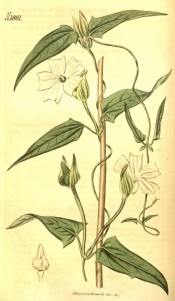Thunbergia fragrans Roxb.
Frost tender, perennial, woody-stemmed climber with triangular leaves, to 7.5cm, and solitary fragrant white flowers with spreading lobes,in summer. To 3m. [RHSD, Hortus].
Horticultural & Botanical History
First botanically described by Roxburgh’s in his Plants of the Coast of Coromandel. ‘This plant is common in hedges, among bushes, on the banks of water-courses, about Samulcotah; I have not met with it elsewhere. Flowers during the wet and cold seasons; when cultivated it flowers all the year. The plant possesses a peculiar and agreeable fragrance, and the beauty of its flowers, though not fragrant, intitles it to a place in the flower garden.’ [Roxburgh vol.1, p.47 & t.67/1795].
‘Thunbergia fragrans has a climbing shrubby stem, which in the East-Indies reaches the length of from four to six yards, but we have never seen it exceed that of a few feet in our hot-houses, where, however, it well deserves a place, being almost constantly in blossom. The flowers are quite scentless, nor have we observed any fragrance in any part of the plant; but Dr. Roxburgh in his Plants of the Coast of Coromandel, states positively, that ‘the plant possesses a peculiar and agreeable fragrance, and the beauty of the flowers, although not fragrant, entitle it to a place in the flower-garden;’ so that the absurd notion, prevailing among the Nurserymen, which originated perhaps in the Botanist’s Repository, that Dr. Roxburgh gave it the name of fragrans, because the place where it grew was sweet scented, though the plant was not so, seems to be entirely void of foundation. Perhaps the heat of a tropical sun is necessary to bring forth its odour. Native of the East-Indies; growing plentifully in the hedges and bushes on the banks of the water courses near Samulcotah, on the Coromandel coast. With us it is an inhabitant of the bark-stove Is propagated by cuttings or by seeds, which sometimes come to maturity in this country. Introduced into the Kew Garden by Mr. Peter Good, in the year 1796; but we believe it first flowered in the Dowager Lady De Clifford’s stove, at Paddington.’ [BM t.1881/1817].
‘A delicate stove climber. It has been long in cultivation, and is well deserving a place, being almost perpetually adorned with its snow white blossoms. It is said to have been introduced in 1796 by the late Lady de Clifford.’ [LBC no.1913/1833].
History at Camden Park
Desideratum to Loddiges’ Nursery, 6th January 1845 [MP A2933-2, p.28], the probable source although this plant was not listed in a catalogue until 1857 [T.967/1857].
Notes
Thunbergia fragrans Drege ex C.Presl = Thunbergia dregeana C.Presl, a woody climber from South Africa with ovate, toothed leaves and yellow flowers. [RHSD].
Thunbergia fragrans Wall. (1828-49) = Thunbergia tomentosa Wall. ex Nees, another tropical Asian species.
These two plants are perhaps a less likely identification of Macarthur’s ‘Thunbergia fragrans’.
Published Feb 22, 2010 - 04:34 PM | Last updated May 02, 2011 - 05:08 PM
| Family | Acanthaceae |
|---|---|
| Category | |
| Region of origin | Tropical Asia |
| Synonyms |
|
| Common Name | |
| Name in the Camden Park Record |
Thunbergia fragrans |
| Confidence level | high |


